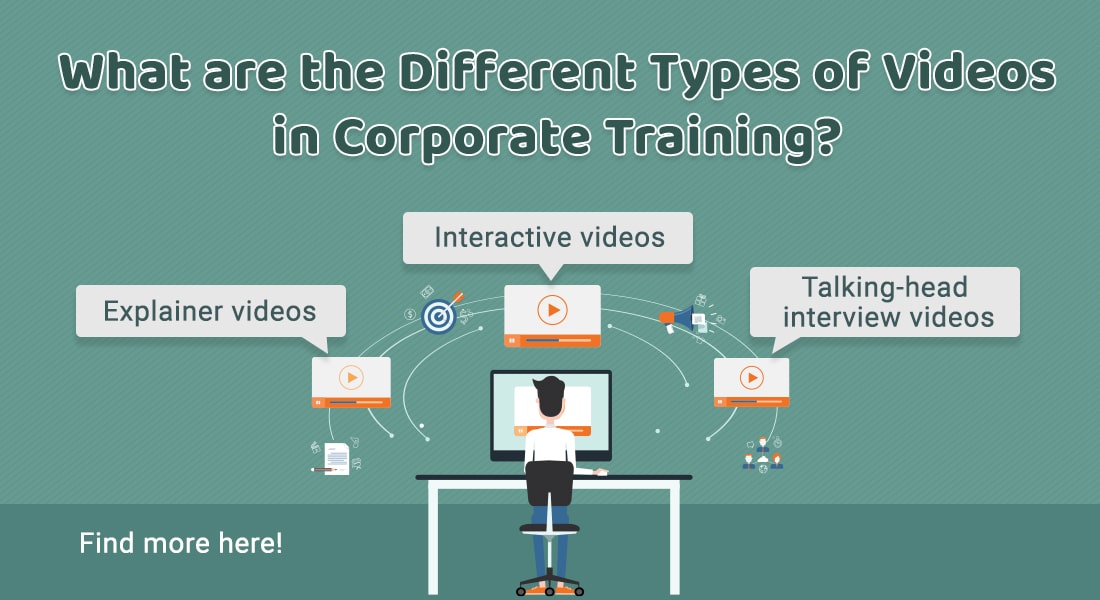Video-based Learning for Corporate Training: Key Strategies, Tools

In today’s fast-paced, technology-driven world, video-based learning has become an essential part of corporate training. It offers a dynamic, interactive, and easily accessible way to deliver information, engage learners, and improve retention rates. Whether you’re introducing new products, enhancing employee skills, or providing ongoing training, leveraging video can significantly boost the effectiveness of your training programs.
Video-based learning has revolutionized corporate training, enabling immersive, interactive, and flexible learning experiences for employees across various industries. With the rise of digital learning and the need for remote-friendly solutions, organizations are increasingly integrating video into their learning strategies.
→ Download Now: Are You Ready to Charm Your Learners with the Magic of Videos?
Let’s explore everything you need to know about video-based learning—from understanding why it’s essential in today’s corporate training landscape to exploring the different types of corporate training videos you can use. You’ll also discover the best tools to create high-quality video content, strategies for successful implementation, and tips for creating training videos that truly resonate with your learners. With video learning at the forefront of corporate training, staying up to date on the latest trends and best practices is crucial to keep your training programs engaging and impactful.
Table of Contents
- Why Video-based Learning?
- Types of Training Videos
- Tools for Creating Video-based Learning Content
- Implementing Video-based Learning in Corporate Training
- Key Benefits of Video-based Learning
- Best Practices for Creating Effective Training Videos
- Future Trends in Video-Based Corporate Training
Why Video-based Learning?
Video-based learning has rapidly gained traction across industries as a powerful training medium. Its ability to deliver information visually and audibly makes it ideal for catering to different learning styles.
In corporate settings, videos can:
- Simplify complex topics
- Provide demonstrations
- Foster an interactive learning environment
Videos improve retention and engagement by making content memorable and digestible, even for complex subject matter. They also allow employees to learn at their own pace. Organizations increasingly rely on video-based learning to streamline knowledge dissemination, improve compliance training, and deliver consistent messaging across dispersed teams.
Video-based learning offers a range of benefits that make it ideal for corporate training, including:
- Enhanced Engagement: Videos incorporate visuals, animations, and audio to create an engaging experience. Studies show that visuals can increase comprehension and retention rates.
- Better Knowledge Retention: Employees remember information better when presented in a visual format, helping to reinforce learning outcomes.
According to Forbes, users perceive and remember 90% more information when they watch a video than when they read text.
- Flexibility and Accessibility: Learners can access videos anytime, anywhere, providing a flexible learning experience. This aspect is crucial for remote and hybrid workforce training.
Relevant Articles on Video Benefits
7 Advantages of Using Videos in eLearning
Types of Corporate Training Videos
A range of video formats cater to diverse training needs. From explainer videos for product training to microlearning snippets and interactive simulations, each video type serves a unique purpose.
Training videos such as animations, live-action demonstrations, and role-play scenarios provide specific learning contexts and reinforce learning objectives effectively.
For example, interactive videos engage learners in decision-making scenarios, while microlearning videos are bite-sized and address focused topics, ideal for quick learning modules.
Corporate training videos can be developed in various formats to meet different learning needs:
- Explainer Videos: Great for introducing concepts in a short and clear way.
- Tutorial Videos: These walk learners through a process or skill, step-by-step.
- Interactive Videos: Include elements such as quizzes, branching scenarios, and clickable sections to actively engage learners.
Watch this video and learn how to create interactive videos for corporate training!
- Microlearning Videos: Microlearning videos focused on one specific topic, ideal for quick knowledge refreshers.
- Role-Play and Simulation Videos: Useful for practicing customer interactions, product handling, or other scenarios requiring experiential learning.
For more insights into types of videos and use cases, visit Training Videos: Types and Use Cases.
Tools for Creating Video-based Learning Content
Level Up Your Video-Based Learning for Top-notch Corporate Training!
Bring your custom eLearning to life and engage your learners with these top video creation softwares:
Vyond
iSpring
Synthesia
Colossyan
Creating impactful video content requires the right tools to streamline production and enhance quality. Various video creation softwares such as Vyond, iSpring, and Synthesia, cater to different aspects of video creation—whether it's creating animated explainer videos, recording live sessions, or designing interactive elements.
These tools allow creators to design professional and brand-aligned videos quickly and efficiently. Choosing the right tools can greatly simplify the process of creating effective video content.
Here are some popular tools:
Vyond: Known for creating engaging explainer videos with customizable animations.
iSpring: This tool is well-suited for video recording and editing, making it a great choice for eLearning videos.
Synthesia: A powerful tool for creating AI-powered avatar videos, useful for multilingual and culturally inclusive content.
Colossyan: This tool provides AI-driven options for rapid video creation and localization.
Explore more Video Development Tools to find the best fit for your organization.
Implementing Video-based Learning in Corporate Training
Successfully integrating video-based learning in corporate training requires strategic planning and implementation. A phased approach includes:
- Identifying training needs
- Selecting appropriate video formats
- Incorporating interactive elements to engage learners.
Additionally, companies should evaluate platforms for delivering videos, such as Learning Management Systems (LMS) or dedicated video-hosting services. By embedding video-based learning into existing training programs, organizations can ensure consistent learning experiences and maximize reach.
Steps for incorporating video-based learning in training programs.
1. Define Learning Objectives:
Determine what the video needs to achieve. Clear objectives guide the content and format.
2. Incorporate Interactivity:
Interactive elements such as quizzes or clickable links increase engagement and learning retention.
- Learn more about Interactive Video Strategies for Corporate Training.
3. Leverage Microlearning:
Breaking content into small, manageable videos can boost engagement.
4. Ensure Accessibility:
Videos should be inclusive, with features such as closed captions, transcripts, and language options for diverse workforces.
Key Benefits of Video-based Learning
Video-based learning offers several advantages, making it a popular choice in corporate training. It:
- Improves knowledge retention by leveraging visuals
- Enhances accessibility
- Allows for scalable training solutions across global teams
Videos also support microlearning and blended learning, enabling learners to review content on-demand and in various contexts. By adopting video-based training, companies can deliver consistent and standardized learning experiences, reducing the costs associated with instructor-led training.

Next-Gen Training: Unlocking the Power of AI in Video-based Learning
Elevate your Training Videos with AI
- Relevance of Video-based Learning
- Various Video Formats
- Potential of AI in Videos
- And More!
Here are the benefits of using videos in eLearning and how it enhances engagement and productivity.
1. Increased Learner Engagement
Engaging videos can transform traditional corporate training into dynamic, interactive experiences, which is especially useful for onboarding, product training, and sales training.
For product training examples, see How Videos Can Enhance Product Training.
Also, read about Video-based Learning Benefits in Corporate Training.
2. Improved Knowledge Retention and Performance
Videos reinforce learning by presenting information in a visually appealing format. When combined with microlearning, they provide knowledge that is easy to digest and retain.
Explore Video-based Learning Powered by Technology.
3. Cost-Effective and Scalable Solutions
Once created, videos can be used multiple times across different departments and locations, making them a cost-effective training solution.
Best Practices for Effective Video Creation
To maximize the effectiveness of training videos, organizations should prioritize clarity, engagement, and accessibility. Effective video design includes using simple language, relevant visuals, and an engaging narrative to keep learners' attention.
Incorporating scenarios, quizzes, and other interactive elements further boosts engagement and retention. It's also important to ensure that videos are optimized for mobile access, catering to learners who prefer on-the-go access.
To maximize the impact of training videos, consider these best practices:
- Keep it Short and Focused: Aim for videos that are 3-7 minutes long, especially for microlearning.
- Add Visuals and Animations: Use engaging visuals to illustrate complex concepts and keep learners focused.
Viewers are 60% more likely to watch videos to completion if they begin with high-quality visuals and sound.
Source: How Professional Videos Outperform Amateur Content | LinkedIn
- Use Quality Voiceovers and Subtitles: These enhance understanding and accessibility, especially in multilingual workplaces.
Additional Resources on Best Practices
Future Trends in Video-based Corporate Training
The future of video-based training is promising, with trends such as AI, virtual reality, and augmented reality shaping more immersive experiences. AI-powered video creation tools enable personalized learning journeys, while VR/AR create interactive simulations for real-world scenarios, ideal for industries like healthcare and manufacturing.
Moreover, 5G technology will further enhance video accessibility, enabling seamless streaming and interaction across devices. As these trends evolve, video-based learning is set to become more adaptive, engaging, and personalized, catering to the modern learner's needs.
AI for video creation is shaping the future of video-based learning in corporate training. From AI-generated avatars to customizable animated videos, these innovations enable organizations to create high-quality training content at scale.
For example, AI-driven tools such as Synthesia, Vyond and Colossyan simplify the process of creating multilingual training videos, making it easier to train diverse workforces globally.

Learn more about AI Tools for Video Development and the role of AI in Crafting Multilingual Training Videos.
Conclusion
Incorporating video-based learning into your corporate training strategy can enhance employee engagement, increase knowledge retention, and create an effective learning culture. Whether through microlearning videos, interactive scenarios, or simulations, video is a versatile tool that aligns with modern training needs.
For further reading, explore our Comprehensive Guide to Video-based Learning for Corporate Training and check out Video-based Learning Success Stories for more real-world applications.







